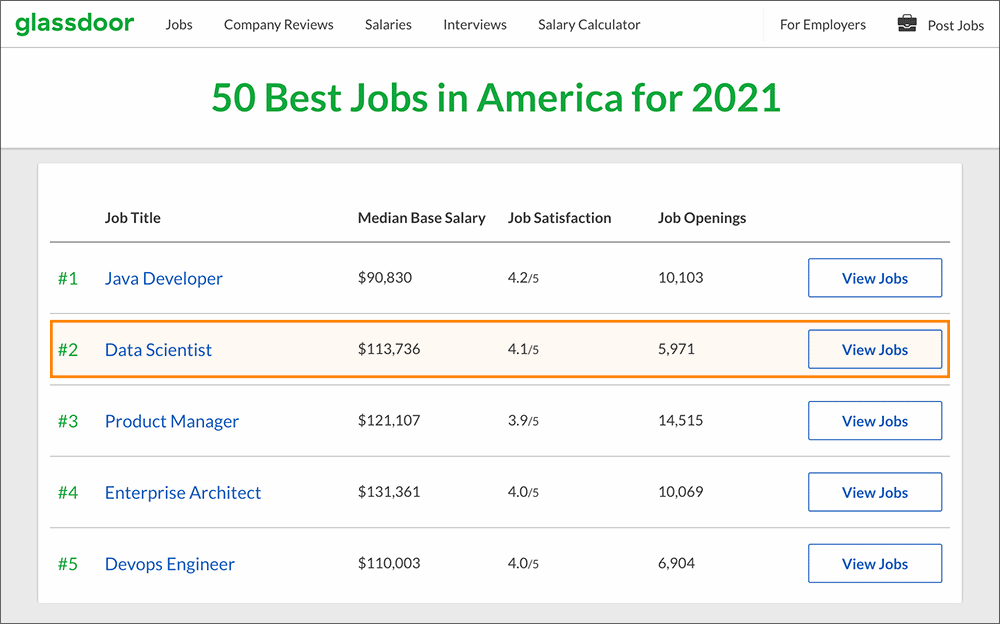The importance of data and how to use it effectively is changing the very fabric of many companies, with Chief Data Officers (CDOs) becoming increasingly important reporting to CIOs, CTOs, CDOs or even CEOs in some organizations. As Google Trends suggests, the demand for this skillset has increased significantly over the last 10 years and continues to increase.

However, while we have a lot of data in today’s marketplace, the value is not the data itself. The value comes from data insights, which inherently find themselves in the data science part of the equation.
Data vs. insights
Executive teams need actionable, data-driven findings that create business value. You need to be able to mine the data, sift and sort it, and draw conclusions that lead to business results.
As management consultants, we view data as an increasingly important part of any organization’s business plan. All of our client engagements involve data in some way, ranging from how to identify it and organize it to how to augment it and monetize it.
We’ve learned a lot about what companies get right, and where things get off track. In this article, you’ll learn the fundamentals of data science, what it is (and what it’s not), how data scientists are being deployed within organizations, and what your organization can do to step up your data science and insights game.
What exactly do data scientists do?
There are myriad definitions for data science and data scientists on the internet but we like this explanation from UC Berkeley. It’s one of the clearest descriptions of what data scientists do and why it is important:
Effective data scientists are able to identify relevant questions, collect data from a multitude of different data sources, organize the information, translate results into solutions and communicate their findings in a way that positively affects business decisions. These skills are required in almost all industries, causing skilled data scientists to be increasingly valuable to companies.
Building data science into your organization
Data scientist has been a top three role on Glassdoor’s 50 Best Jobs in America since 2016, and is currently ranked second.

In addition to data scientist, there are a range of data science roles becoming more common in many data-forward organizations. In the Spring 2021 edition of “Companies Hiring Data Scientists” you’ll see a variety of industries, from digital giants like Geico.com and Workday, to traditional product companies like Stanley Black & Decker. This doesn’t even include those who already have robust data science teams on board.
Data science roles
Data science roles can be broken down into two main types, with some roles being a blend of each:
- Highly technical – for example: database administrator, machine learning engineer
- Business outcome focused – for example: data analyst, business analyst, data and analytics, etc.
Hiring a data scientist vs. developing from within
For business-outcome based roles, this may be an option. Given the popularity and scarcity of data scientists, we’ve seen several clients move high-potential employees into these business-outcome data science roles.
This has been successful in allowing these individuals to augment their subject matter and business expertise with data and technology training. Building an internal pipeline can be a great way to both build your data science capabilities and retain some of your brightest staff.
This is not as easy, however, if you’re wanting the more technical data scientist on your team. That role requires extensive training and experience, which can be found in an external hire or consultant.
Where data science sits in your org chart
Where data science sits in your organizational hierarchy depends on how evolved your data strategy is and who the primary users of data insights are.
Many organizations start with data science in their IT organization. Others start with it in Marketing or even Fiscal Planning and Operations.
However, if data is going to be a primary driver of business strategy (producing revenue, impacting operations, etc.) then it may make sense to build out data science as its own cross-functional department, under a Chief Data Officer who reports directly to the CEO.
Launching a successful data strategy – where to start?
Data science begins with a vision and a belief – the belief that data is the single biggest asset for your organization. This is true for virtually every digitally-driven business.
By recognizing data as your biggest asset, this empowers your team to make the right investments of time, energy and resources.
A successful data strategy begins with the end in mind, specifically:
- A summary of valuable insights
- Data-driven decision making
- Goals and initiatives based on the data insights
This may include using data to improve margins or achieve a higher level of customer satisfaction. This may also lead to the development of data products that drive topline revenue – something that’s especially important for companies looking to differentiate their product mix.
Recommendations and next steps
To put this information into practice, we recommend starting with an assessment of your organization’s data assets, governance structure and organizational capabilities. The results of this assessment will help you understand your areas of strength, gaps to be addressed and allow you to start to map out a data strategy that is aligned with your business goals.

Found this article helpful? You may also enjoy reading:
- What’s your organization’s data worth?
- 5 key data trends that should be on every CEO’s radar
- Steps to achieving a modern data strategy
If you’d like to explore how Mod Op Strategic Consulting can help with your data strategy or data science initiatives, book a free consultation with one of our executives.
















